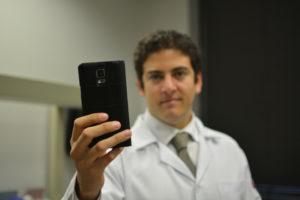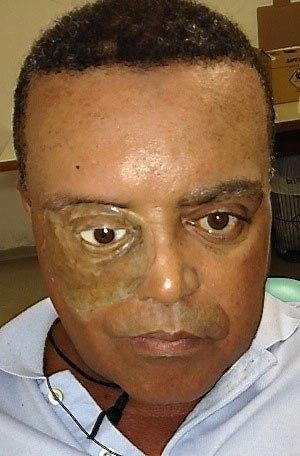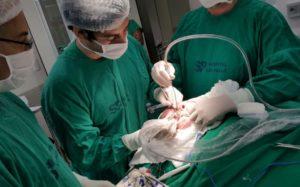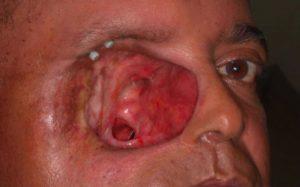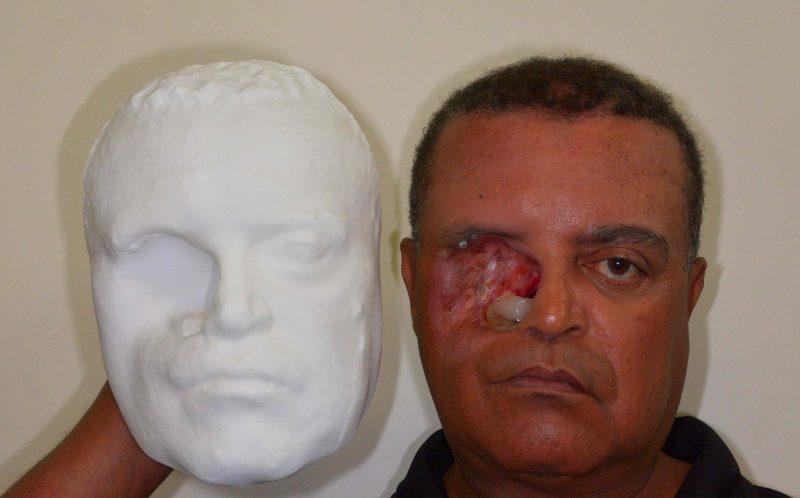The grief and sorrow that cancer causes around the world on a daily basis is one that most everyone understands, as nearly all of us have been touched by the dreadful disease. While it can affect the human body with so many different forms of pain and suffering, the goal of each patient is usually the same: to survive. Achieving this goal and coming out the other side into remission can still be a long and harrowing journey, though, with many issues to deal with, from the physical to the emotional.
Carlito Conceiçao has lived to tell his story but it certainly has not been an easy one. At 54, the São Paulo, Brazil resident—a husband and a father of two—was treated for an upper maxillary carcinoma, a tumor that did great damage not only as a devastating mouth cancer but also as it spread, wreaking havoc in his throat and face.
Doctors operated, stopping the tumor in its tracks before it could attack Conceiçao’s brain. The results weren’t pretty, however, as they had to remove his eye socket on the right side of his face, as well as a portion of his nose. While the doctors had saved him from the further ravages of the tumor and he was indeed still alive, the damage done in the process left Conceaio managing some dark emotions.Conceiçao had a prosthetic already, but as is so often the case with traditional devices created for more difficult issues, it was uncomfortable and did not stay in place very well.“I lost all my confidence and fell into a deep depression,” said Conceiçao. “I felt totally disfigured and looked terrible.”
Luckily, time was on Conceiçao’s side as today we have some breakthrough technologies available to fix just about anything. And Dr. Rodrigo Salazar, a Peruvian dentist and specialist in oral rehabilitation, was able to fix the damage caused by the tumor—thanks to a smartphone app!
Using Autodesk 123D Catch, Dr. Salazar was able to take 15 photos of his patient’s head, all from his phone.“Brazil doesn’t have the resources to equip all of its clinical centers with high-end technology,” said Dr. Salazar. “So, we’ve developed an alternative and simplified low-cost procedure that captures patients’ facial anatomy and generates physical working models, giving us the equivalent results to prostheses produced on state-of-the-art equipment that costs hundreds of thousands of pounds.”
“The rational for using a smartphone is that all modern mobile devices have an integrated accelerometer and a gyroscope sensor, which are automatically run by the application to guide the operator’s 3D position during the photo capture sequence.”
Dr. Salazar then uploaded the images and 3D printed out an affordable mold for the resulting prosthetic, as they worked to ‘mirror’ the other side of Conceiçao’s face. Clinical artists aware of the project actually volunteered their time to put the finishing touches on the facial prosthetic for Conceiçao.
“I was so impressed by the result of the new one,” said Conceiçao. “I cried when they fitted it.”
The prosthetic attaches securely to Conceiçao’s face with magnets that clamp on to screws affixed just under his eyebrow—put into place in a short procedure.
- [Photo: Caters News]
- [Photo: Caters News]
“This is a well-established procedure for anchoring cranio-facial prostheses,” states Dr. Luciano Dib, a maxillofacial surgeon who was involved in the project to help Conceiçao find a more comfortable prosthetic. “It means wearers can confidently go to the beach, take a shower, go to the gym, and run without fear of the prosthesis falling off. And they can take it off at night to clean it.”
This procedure is called Plus ID, and is a collaborative effort with Brazilian and US doctors working together for a low-cost solution for patients in, for example, South America, Asia, and Africa who suffer from facially disfiguring cancers. Dr. Salazar made it clear that the benefits of 3D printing came through clearly in this inspiring project. Along with the ease in scanning, customization, and production, this type of work signals the new trend in patient-specific care we are seeing around the world, thanks to 3D printing—and the care and skill of all the caring medical professionals involved. Discuss in the 3D Printed Facial Prosthetic forum at 3DPB.com.
[Sources: Caters News / New York Post]Subscribe to Our Email Newsletter
Stay up-to-date on all the latest news from the 3D printing industry and receive information and offers from third party vendors.
Print Services
Upload your 3D Models and get them printed quickly and efficiently.
You May Also Like
Making 3D Printing Personal: How Faraz Faruqi Is Rethinking Digital Design at MIT CSAIL
What if your 3D printer could think more like an intelligent assistant, able to reason through a design idea, ask questions, and deliver something that works exactly the way the...
Reinventing Reindustrialization: Why NAVWAR Project Manager Spencer Koroly Invented a Made-in-America 3D Printer
It has become virtually impossible to regularly follow additive manufacturing (AM) industry news and not stumble across the term “defense industrial base” (DIB), a concept encompassing all the many diverse...
Heating Up: 3D Systems’ Scott Green Discusses 3D Printing’s Potential in the Data Center Industry
The relentless rise of NVIDIA, the steadily increasing pledges of major private and public investments in national infrastructure projects around the world, and the general cultural obsession with AI have...
Formlabs Teams Up with DMG MORI in Japan
In late June, Nick Graham, Chief Revenue Officer at Formlabs, announced on LinkedIn that the company had partnered with DMG MORI, one of the world’s leading machine tool companies, to...



